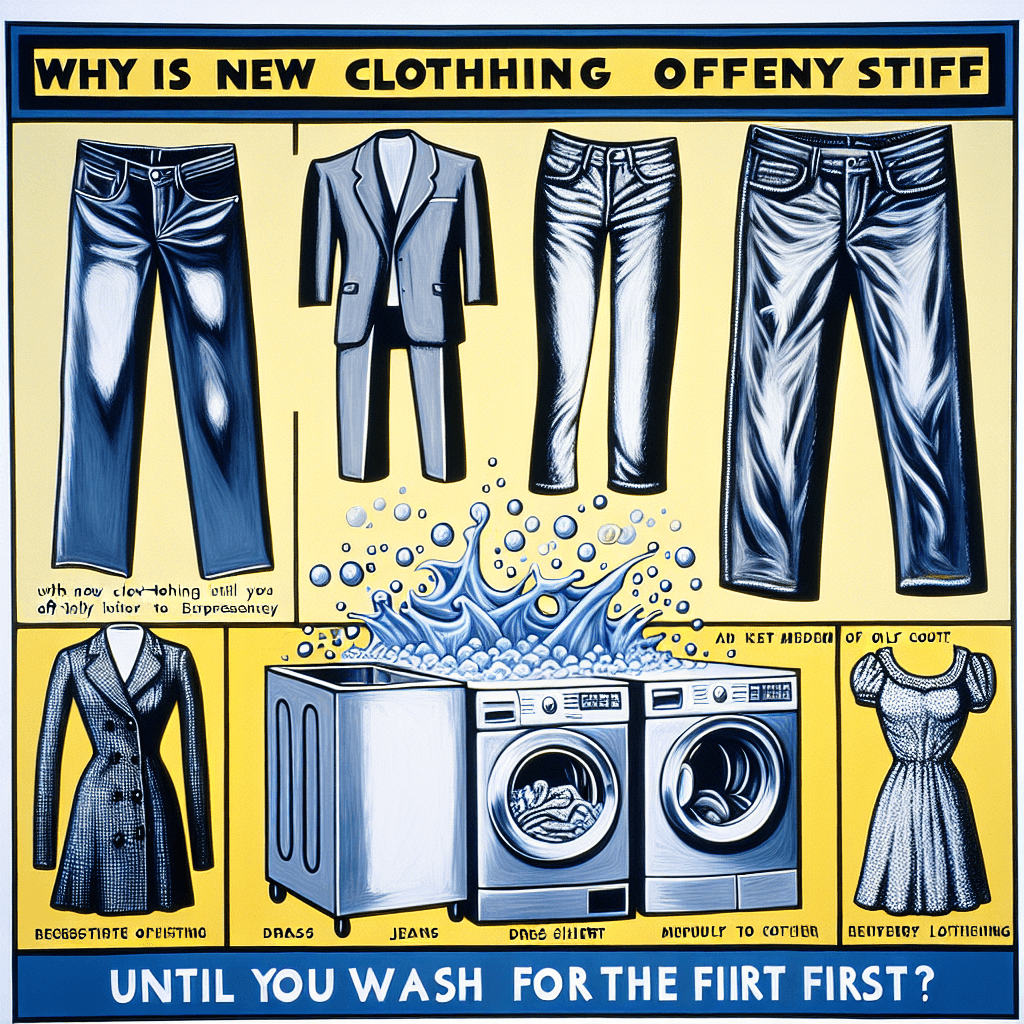Why is new clothing often stiff until you wash it for the first time
That stiff, 'fresh-off-the-rack' feeling isn't just newness—it's a surprising chemical finish designed for the store shelf, not your skin.


Too Long; Didn't Read
TLDR: New clothes are coated in chemicals and starches called sizing to keep them looking crisp and wrinkle-free during shipping and in stores. Washing the garment for the first time removes this stiff coating, revealing the fabric's natural soft texture.
The Science of Stiff: Why Is New Clothing Often Stiff Until You Wash It for the First Time?
Have you ever brought home a brand-new t-shirt or a crisp pair of jeans, only to find they feel more like cardboard than comfortable clothing? You're not alone. That initial stiffness is a near-universal experience, but it’s not a sign of low quality. In fact, it's an intentional and crucial part of the global textile manufacturing process. This stiff, unworn feeling is the result of a fascinating journey from the factory loom to the retail shelf. This post will unravel the mystery, exploring the specific treatments and processes that make your new clothes stiff and why that first wash acts as the magic reset button, transforming them into the soft garments you love.
The Primary Culprit: Sizing Agents
The biggest reason for that new-garment rigidity is a treatment called "sizing." Before individual threads are woven into fabric on high-speed industrial looms, they are coated in a protective solution. This solution, known as sizing, is typically a starch-based mixture or a synthetic polymer like polyvinyl alcohol (PVA).
Why is this necessary? Think of a single thread being subjected to immense friction and tension as it's rapidly woven by a machine. Without a protective coating, the delicate fibers would fray, snag, and break, leading to production shutdowns and flawed fabric. Sizing provides the following benefits:
- Strength: It glues the individual fibers of the yarn together, making it stronger and more resilient.
- Lubrication: It smooths the surface of the thread, reducing friction as it passes through the weaving machinery.
- Stiffness: It makes the yarn stiff and manageable, ensuring a uniform and efficient weaving process.
This starchy coating is the main source of that "crisp" feel. It's designed to be a temporary shield during manufacturing and is meant to be washed out by the consumer.
Dyes, Finishes, and Other Chemical Treatments
Beyond sizing, a cocktail of other chemicals is applied during the "finishing" stage of production. These treatments give the final garment its desired look, feel, and performance characteristics, but they often contribute to its initial stiffness.
Excess Dyes
New garments, especially those with deep, saturated colors like dark denim or bright reds, often carry excess dye on the surface of the fibers. This residue hasn't fully bonded with the fabric and can create a slightly crusty or rough texture. This is also why clothing labels almost always recommend washing dark colors separately for the first few washes—the water helps rinse away this excess dye, which prevents it from bleeding onto other clothes.
Performance Finishes
Modern clothing is often treated with chemicals to add specific functionalities. These include:
- Formaldehyde Resins: Commonly used to create "wrinkle-resistant" or "permanent press" finishes. These resins work by creating cross-links between the fabric's polymer chains, making them less prone to creasing. However, this process can also make the fibers less flexible and feel stiff at first.
- Anti-Mildew and Preservative Agents: To protect clothing during long, often humid, journeys in shipping containers and storage warehouses, manufacturers apply biocides and fungicides. These chemicals prevent mold and mildew from growing but can add to the fabric's unyielding texture.
The Magic of the First Wash
The first wash is the final, crucial step in the manufacturing process—one that you complete at home. Here’s what happens when you launder a new garment:
- Chemicals Dissolve: The water and detergent work together to break down and wash away the sizing agents, excess dyes, and most of the finishing chemicals.
- Fibers Relax: The agitation of the washing machine, combined with the removal of the stiffening agents, allows the tightly woven fibers of the fabric to relax, loosen, and soften. The heat from a dryer can further enhance this process.
This simple act transforms the garment from a mass-produced product into a soft, comfortable piece of clothing ready for your wardrobe.
Conclusion
That initial stiffness in new clothing isn't a flaw but a feature of modern textile production. It’s a temporary side effect of processes like sizing and chemical finishing, which are designed to create durable, visually appealing, and well-preserved garments efficiently. The first wash is the essential final touch, stripping away the manufacturing residue and allowing the fabric's true softness and character to emerge. So, the next time you feel a stiff new shirt, you’ll know it’s not a defect—it’s just waiting for a good wash to feel like home. This is also a great reminder of why it’s always wise to wash new clothes before wearing them, not just for comfort, but to rinse away any residual chemicals that could irritate sensitive skin.
More Articles

Why is it easier to balance on a moving bicycle than a stationary one?
It’s a paradox of motion we've all experienced: the very act of moving forward is what keeps you from falling over. Discover the surprising physics that allows a bicycle to practically balance itself.

Why is it often illegal to pick up a bird feather?
That beautiful feather you found on your walk seems like an innocent keepsake, but taking it home could actually be a federal offense.

Why do raindrops on a moving car's side windows race sideways instead of down?
It’s a tiny, everyday mystery you've seen a thousand times. Discover the invisible aerodynamic forces that overpower gravity and send raindrops racing sideways across your window.